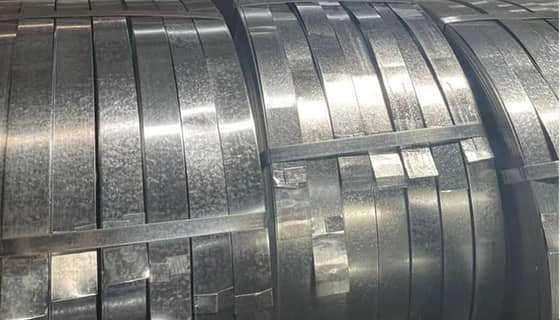Stainless steel strips are versatile and essential materials in various industries. From their exceptional corrosion resistance to their high strength, stainless steel strips offer a wide range of properties that make them indispensable. Manufacturers and designers alike rely on stainless steel strips for applications ranging from architectural to industrial. In this blog post, we will explore the properties, uses, advantages, types, manufacturing process, and maintenance of stainless steel strips, shedding light on their significance in different sectors. Whether you’re a professional in the field or simply keen on learning about stainless steel strips, this comprehensive guide has you covered.
Introduction to Stainless Steel Strips
Stainless steel strips are narrow, long, flat-rolled metal products that are widely used in various industries. They are known for their exceptional corrosion resistance, strength, and versatility, making them a popular choice for many applications. Here’s what you need to know about stainless steel strips:
Definition: Stainless steel strips are thin, flat metal strips made from stainless steel, a steel alloy with a minimum of 10.5% chromium content by mass.
Composition: They are typically composed of iron, carbon, and various other elements such as nickel, manganese, and molybdenum, which contribute to their unique properties.
Versatility: These strips come in different grades and finishes, offering flexibility for use in diverse environments and applications.
Applications: From automotive and aerospace industries to construction and household appliances, stainless steel strips are utilized in a wide range of products and equipment.
Durability: Their ability to withstand high temperatures, corrosion, and impact makes them ideal for challenging and demanding settings.
Stainless steel strips play a crucial role in modern manufacturing and construction, offering durability and reliability across various industries.
Properties of Stainless Steel Strips
Stainless steel strips exhibit a range of properties that make them highly versatile and suitable for various applications. Some of the key properties include:
Corrosion Resistance: Stainless steel strips are highly resistant to corrosion, making them ideal for use in challenging environments such as marine and chemical industries. This resistance is due to the presence of chromium in the steel, which forms a protective oxide layer on the surface.
Strength and Durability: These strips offer exceptional strength and durability, making them capable of withstanding high-stress applications. This property ensures longevity and reliability in diverse operating conditions.
Heat Resistance: Stainless steel strips can withstand high temperatures without experiencing deformation or structural degradation, making them suitable for applications involving heat exposure.
Hygienic Properties: Stainless steel strips have hygienic properties, as they are non-porous and resistant to bacteria and germs. This feature makes them popular in the food and medical industries.
Aesthetic Appeal: The smooth finish and lustrous appearance of stainless steel strips contribute to their aesthetic appeal, making them a popular choice for architectural and decorative purposes.
These properties collectively position stainless steel strips as a premium material for various industrial, commercial, and residential uses, making them a highly sought-after material in numerous sectors.
By understanding these properties, users can capitalize on the unique characteristics of stainless steel strips to meet specific application requirements.
Common Uses of Stainless Steel Strips
Stainless steel strips are incredibly versatile and find applications across various industries due to their exceptional properties. Some common uses of stainless steel strips include:
Automotive Industry: Stainless steel strips are widely used in the automotive sector for making parts like exhaust systems, trim, and molding.
Construction: In construction, stainless steel strips are used for structural support, cladding, roofing, and decorative purposes due to their durability and corrosion-resistant nature.
Kitchen Appliances: Many kitchen appliances, such as refrigerators, stoves, and dishwashers, utilize stainless steel strips for their sleek appearance and anti-corrosive properties.
Medical Equipment: Stainless steel strips are an integral component in medical equipment such as surgical instruments, dental tools, and implants due to their hygienic and sterilizable nature.
Electronics: The electronics industry makes use of stainless steel strips in the production of components like mobile phone frames, computer hardware, and electronic enclosures.
Oil and Gas Industry: Stainless steel strips are utilized in the oil and gas sector for tubing, pipelines, and various structural components due to their resistance to harsh environmental conditions.
Stainless steel strips are chosen for these applications due to their corrosion resistance, strength, and aesthetic appeal, making them a top choice across diverse industries.
Remember that using high-quality stainless steel strip is vital for the success of any project in these industries.
Advantages of Stainless Steel Strips
Stainless steel strips offer a wide range of advantages, making them a popular choice in various industries. Some of the key advantages include:
- Corrosion Resistance: Stainless steel strips are highly resistant to corrosion, making them ideal for applications in harsh and corrosive environments.
- Strength and Durability: These strips are known for their exceptional strength and durability, ensuring long-term performance and reliability.
- Aesthetic Appeal: With a sleek and modern appearance, stainless steel strips are favored for their aesthetic appeal, adding a touch of sophistication to any application.
- Hygienic Properties: The non-porous surface of stainless steel makes it easy to clean and maintain, promoting hygiene in food processing and medical settings.
- Temperature Resistance: Stainless steel strips can withstand high and low temperatures, making them suitable for applications in extreme thermal conditions.
In comparison to other materials, stainless steel strips stand out for their impressive combination of strength, corrosion resistance, and aesthetic appeal, making them a versatile and practical choice for a wide range of applications.
Different Types of Stainless Steel Strips
When it comes to stainless steel strips, there are different types available, each with its own unique properties and applications. Here are some of the most common types:
Austenitic Stainless Steel Strips: Known for their excellent corrosion resistance and formability, austenitic stainless steel strips are widely used in various industries, including food processing, pharmaceuticals, and chemical processing.
Ferritic Stainless Steel Strips: These strips are highly resistant to stress corrosion cracking and have good resistance to corrosion and oxidation at elevated temperatures. They are commonly used in automotive applications, architectural trim, and kitchen equipment.
Martensitic Stainless Steel Strips: Martensitic strips are known for their high strength and hardness. They find applications in making cutting tools, surgical instruments, and industrial equipment.
Duplex Stainless Steel Strips: These strips have a two-phase microstructure of austenitic and ferritic stainless steel, offering a good combination of strength and corrosion resistance. They are commonly used in the chemical processing and oil & gas industries.
By understanding the different types of stainless steel strips available, you can choose the most suitable option for your specific application, whether it’s for architectural, industrial, or consumer use.
Manufacturing Process of Stainless Steel Strips
Stainless steel strips are manufactured through a meticulous process to ensure the highest quality and durability. The manufacturing process involves several key steps, including:
Melting and Casting: The process begins with the melting of raw materials, including iron ore, coal, and limestone, in a blast furnace. The molten metal is then cast into large slabs, which will later be processed into strips.
Hot Rolling: The cast slabs are heated and passed through a series of rolling mills to reduce the thickness and increase the length of the metal. This hot rolling process creates long sheets of steel that will eventually be cut into strips.
Annealing: The hot-rolled steel strips undergo annealing, a heat treatment process that removes internal stresses and softens the material. This improves the formability and machinability of the steel.
Cold Rolling: The annealed strips are further processed through cold rolling mills, where they are passed through a series of rollers at room temperature. This process helps to achieve the desired thickness and surface finish.
Finishing and Coating: The final steps involve finishing the strips to meet specific requirements, such as precision cutting, edge trimming, and applying protective coatings to enhance corrosion resistance.
By following this meticulous manufacturing process, stainless steel strips are produced with exceptional quality and consistency, making them ideal for a wide range of industrial applications.
Remember, using high-quality stainless steel strips ensures the durability and longevity of your project or product, making it a wise investment for the long term.
Care and Maintenance of Stainless Steel Strips
Stainless steel strips are known for their durability and resistance to corrosion, but proper care and maintenance are essential to ensure their longevity and performance. Here are some key points to consider for the care and maintenance of stainless steel strips:
Regular Cleaning: Use a mild detergent or specially formulated stainless steel cleaner to remove any dirt, grime, or fingerprints from the surface of the stainless steel strips.
Avoid Abrasive Cleaners: Refrain from using abrasive cleaners, scouring pads, or steel wool, as these can scratch the surface of the stainless steel strips, compromising their appearance.
Directional Cleaning: When cleaning, always wipe in the direction of the stainless steel grain to maintain its aesthetic appeal and minimize the risk of scratching.
Routine Inspection: Periodically inspect the stainless steel strips for any signs of damage, discoloration, or corrosion. Address any issues promptly to prevent further deterioration.
Protective Coatings: Consider applying a protective coating or rust inhibitor to the stainless steel strips, especially in harsh environments or outdoor applications.
Avoid Contamination: Prevent contact with chlorides, such as those found in certain cleaning products, as they can cause pitting corrosion on the surface of the stainless steel.
Proper care and maintenance will not only preserve the visual appeal of stainless steel strips but also contribute to their overall performance and longevity.
Remember to follow these steps to ensure that your stainless steel strips remain in optimal condition for years to come.



